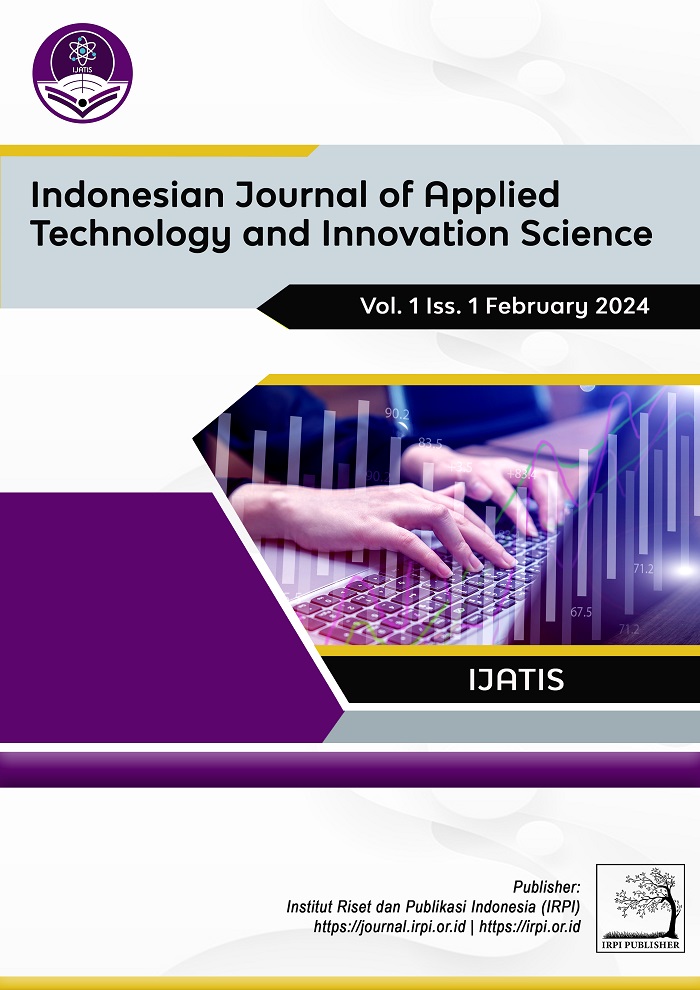Application of Artificial Neural Network, K-Nearest Neighbor and Naive Bayes Algorithms for Classification of Obesity Risk Cardiovascular Disease
DOI:
https://doi.org/10.57152/ijatis.v1i1.1095Keywords:
Artificial Neural Network, Classification, K-Nearest Neighbor, Naive Bayes, ObesityAbstract
The rate of obesity sufferers continues to increase every year. This happens due to improper lifestyle and diet, as well as various physical conditions. This research aims to analyze the level of obesity using data mining techniques with classification algorithms. This research was conducted on people from countries on the American continent between the ages of 14 and 61 years. Data is collected and information is processed using a web platform that includes surveys where anonymous users answer each question to obtain 17 attributes and 2111 records. This research uses 3 algorithms, namely the Artificial Neural Network algorithm, K-Nearest Neighbor and Naive Bayes. People who are obese are also at higher risk of experiencing health problems, such as asthma, stroke, heart disease, diabetes and cancer. The results after comparing the three algorithms, it is better to use the k-nearest neighbor algorithm compared to Artificial Neural Network and Naive Bayes because the accuracy is 95.74%. Therefore, the K-Nearest Neighbor algorithm is very suitable to use when classifying data.
References
Z. Shan et al., “Association Between Healthy Eating Patterns and Risk of Cardiovascular Disease,” JAMA Intern Med, vol. 180, no. 8, pp. 1090–1100, Aug. 2020, doi: 10.1001/JAMAINTERNMED.2020.2176.
J. P. Chaput, “Sleep patterns, diet quality and energy balance,” Physiol Behav, vol. 134, no. C, pp. 86–91, 2014, doi: 10.1016/J.PHYSBEH.2013.09.006.
R. N. Haththotuwa, C. N. Wijeyaratne, and U. Senarath, “Worldwide epidemic of obesity,” Obesity and Obstetrics, pp. 3–8, Jan. 2020, doi: 10.1016/B978-0-12-817921-5.00001-1.
C. Cercato and F. A. Fonseca, “Cardiovascular risk and obesity,” Diabetol Metab Syndr, vol. 11, no. 1, pp. 1–15, Aug. 2019, doi: 10.1186/S13098-019-0468-0/TABLES/1.
A. Y. A. A. Baioumi, “Comparing Measures of Obesity: Waist Circumference, Waist-Hip, and Waist-Height Ratios,” Nutrition in the Prevention and Treatment of Abdominal Obesity, pp. 29–40, Jan. 2019, doi: 10.1016/B978-0-12-816093-0.00003-3.
H. Wang, “Analysis and Prediction of CET4 Scores Based on Data Mining Algorithm,” Complexity, vol. 2021, 2021, doi: 10.1155/2021/5577868.
H. Wickham, M. C?etinkaya-Rundel, and G. Grolemund, “R for data science?: import, tidy, transform, visualize, and model data,” p. 548, Accessed: Jan. 01, 2024. [Online]. Available: https://books.google.com/books/about/R_for_Data_Science.html?hl=id&id=xU-gzwEACAAJ
E. H. A. Rady and A. S. Anwar, “Prediction of kidney disease stages using data mining algorithms,” Inform Med Unlocked, vol. 15, p. 100178, Jan. 2019, doi: 10.1016/J.IMU.2019.100178.
A. N. Arbain and B. Y. P. Balakrishnan, “A Comparison of Data Mining Algorithms for Liver Disease Prediction on Imbalanced Data,” International Journal of Data Science and Advanced Analytics, vol. 1, no. 1, pp. 1–11, Feb. 2019, Accessed: Jan. 01, 2024. [Online]. Available: https://ijdsaa.com/index.php/welcome/article/view/2
Y. Zhao, C. Zhang, Y. Zhang, Z. Wang, and J. Li, “A review of data mining technologies in building energy systems: Load prediction, pattern identification, fault detection and diagnosis,” Energy and Built Environment, vol. 1, no. 2, pp. 149–164, Apr. 2020, doi: 10.1016/J.ENBENV.2019.11.003.
T. A. Welborn and S. S. Dhaliwal, “Preferred clinical measures of central obesity for predicting mortality,” Eur J Clin Nutr, vol. 61, no. 12, pp. 1373–1379, Dec. 2007, doi: 10.1038/SJ.EJCN.1602656.
M. M. Saritas and A. Yasar, “Performance Analysis of ANN and Naive Bayes Classification Algorithm for Data Classification,” International Journal of Intelligent Systems and Applications in Engineering, vol. 7, no. 2, pp. 88–91, Jun. 2019, doi: 10.18201//ijisae.2019252786.
Ü. A?bulut, A. E. Gürel, and Y. Biçen, “Prediction of daily global solar radiation using different machine learning algorithms: Evaluation and comparison,” Renewable and Sustainable Energy Reviews, vol. 135, p. 110114, Jan. 2021, doi: 10.1016/J.RSER.2020.110114.
S. Chen, G. I. Webb, L. Liu, and X. Ma, “A novel selective naïve Bayes algorithm,” Knowl Based Syst, vol. 192, p. 105361, Mar. 2020, doi: 10.1016/J.KNOSYS.2019.105361.
M. Wongkar and A. Angdresey, “Sentiment Analysis Using Naive Bayes Algorithm Of The Data Crawler: Twitter,” Proceedings of 2019 4th International Conference on Informatics and Computing, ICIC 2019, Oct. 2019, doi: 10.1109/ICIC47613.2019.8985884.
M. Canesche, L. Bragança, O. P. V. Neto, J. A. Nacif, and R. Ferreira, “Google Colab CAD4U: Hands-on cloud laboratories for digital design,” Proceedings - IEEE International Symposium on Circuits and Systems, vol. 2021-May, 2021, doi: 10.1109/ISCAS51556.2021.9401151.
S. Sarma, S. Sockalingam, and S. Dash, “Obesity as a multisystem disease: Trends in obesity rates and obesity-related complications,” Diabetes Obes Metab, vol. 23 Suppl 1, no. S1, pp. 3–16, Feb. 2021, doi: 10.1111/DOM.14290.
S. Khatir, S. Tiachacht, C. Le Thanh, T. Q. Bui, and M. Abdel Wahab, “Damage assessment in composite laminates using ANN-PSO-IGA and Cornwell indicator,” Compos Struct, vol. 230, p. 111509, Dec. 2019, doi: 10.1016/J.COMPSTRUCT.2019.111509.
M. M. Saritas and A. Yasar, “Performance Analysis of ANN and Naive Bayes Classification Algorithm for Data Classification,” International Journal of Intelligent Systems and Applications in Engineering, vol. 7, no. 2, pp. 88–91, Jun. 2019, doi: 10.18201//ijisae.2019252786.
N. Aalimahmoody, C. Bedon, N. Hasanzadeh-Inanlou, A. Hasanzade-Inallu, and M. Nikoo, “BAT Algorithm-Based ANN to Predict the Compressive Strength of Concrete—A Comparative Study,” Infrastructures 2021, Vol. 6, Page 80, vol. 6, no. 6, p. 80, May 2021, doi: 10.3390/INFRASTRUCTURES6060080.










